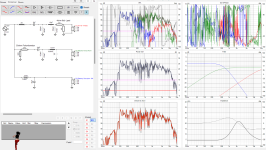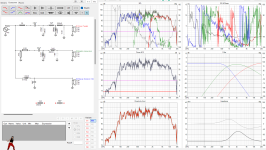Perhaps more appropriate is vituixcad . See the first post in this thread https://www.diyaudio.com/community/threads/i-finished-my-speakers-take-a-look.402940/
Oh yeah I really like this second software you suggested. It's much easier for me. I guess now the question is, what would be the best software for creating these frequency response files? I have just been running tone sweeps to see what im looking at. I do have a microphone that will do it. I just need to generate files. I don't have a padded room or anything but it just needs something to go off of. Any ideas there? And thanks again you have been very helpful already!
It's been interesting. The horns just cause questionable problems. I have 2 (of many) crossover renditions I modeled. They are slightly incorrect since I don't have an SPL meter. Still notice the first graph that looks terrible in comparison to the second actually sounds better than the second. I guess it goes to show sometimes response isn't the only most important factor. The biggest problem is definitely that 50-ohm potentiometer and horn setup. Do you think that huge impedance spike is okay? I look at that and just assume its going to blow up amps, but it's basically how Peavey had it in the first place other than the Piezo's coming off of it as well. Definitely need it to turn down the horns. I'm not sure what route to go. If this is acceptable impedance I might just leave it like that. If not I might just have to remove them. Thoughts?
Attachments
An impedance of 20 ohm is not going to blow up anything. I'd more worry about the 4 ohm base impedance if I had a one transistor pair output amp, but you have a tube amp. Tube output transformers can develop too high voltage running into 2000 ohms or more. 20 is much less than that.
Honestly yeah I think I have the kink's worked out mostly. Looks like because of that potentiometer, the amp always sees 45-ohm on the horns. Might exceed that or be less in circuit like we were seeing. A couple of other things really helped the sound out a lot. One was a problem with the midrange xover not actually being a complete 1st order. Once I put a 1mH coil on the signal the weird reverberation effect seemed to go away. Really other than the tweeter section is all new since the old piezo's didn't have anything on them, which I will kinda miss but not that sibilance spike they did. The woofer I also adjusted with the larger 2mH coil. It loses a bit in the 500hz area but it makes the bass hit so much more smooth and deep its worth the sacrifice. So now I have some parts to order and and just time to build out the rest. Thanks for all your help!
Personally I would be more annoyed by 10 db loss at 80 hz and 20 db loss at 60 hz, from a 15" driver. I would build a bigger box tuned at 54 hz with a port. I listen to piano & organ media that go down to 60 hz frequently and 30 hz occasionally. The SP2-xt is 3 db down at 54 hz volume is 185 L or 6.53 cuft less the drivers volumes.
I'm new here , read some info in speaker impedance have to ask...I have a pair of 3-way 12" woofer cabinets. On the back they are rated like 170 watt and 8 Ohms. Last summer I replaced the 12" in both with a 4 Ohm 12's... . The seller said it would not hurt anything and give me better bass.
So what Ohms is the cabinet (s) now? a tweeter and mid at 8 and the 12" at 4 Yes there is some sort of crossover in there and like a capacitor or two. I don't remember. I know nothing about that technically. The cabinets run as one don't they..? Like it was an 8 Ohm speaker now what is it ?
So what Ohms is the cabinet (s) now? a tweeter and mid at 8 and the 12" at 4 Yes there is some sort of crossover in there and like a capacitor or two. I don't remember. I know nothing about that technically. The cabinets run as one don't they..? Like it was an 8 Ohm speaker now what is it ?
If your source track has a whole lot of bass, like hip hop or modern pop (think Rihanna), then the 4 ohm woofer will consume lots of current and your amp will heat up like a 4 ohm load. If your track has only mid-range like Frank Sinatra or Les Brown and the Band of Renown, then your amp will feel 8 ohms. The tweeter probably has series resistors to lower output to the same level as mid & bass.
I blew output transistors of a single pair MJ15003 amp with a speaker that had two parallel 16 ohm woofers replaced with parallel 8 ohm woofers. The side with the original load, 8 ohms, was fine. The 4 ohm side burned my amp up. I was only using about 10 watts/channel but it was a 4 hour choir rehearsal. Amp had a really crummy heat sink. I have since added fans on the output transistors. The 4 ohms speaker was stolen; bad luck for the next fool that buys it.
I blew output transistors of a single pair MJ15003 amp with a speaker that had two parallel 16 ohm woofers replaced with parallel 8 ohm woofers. The side with the original load, 8 ohms, was fine. The 4 ohm side burned my amp up. I was only using about 10 watts/channel but it was a 4 hour choir rehearsal. Amp had a really crummy heat sink. I have since added fans on the output transistors. The 4 ohms speaker was stolen; bad luck for the next fool that buys it.
- Home
- Live Sound
- PA Systems
- Mixed impedance crossover wiring and amp load

